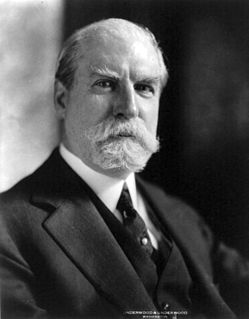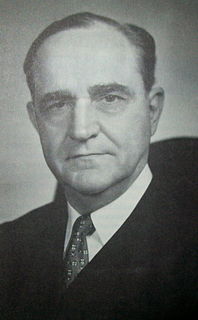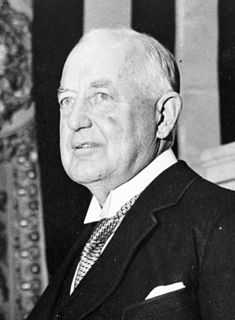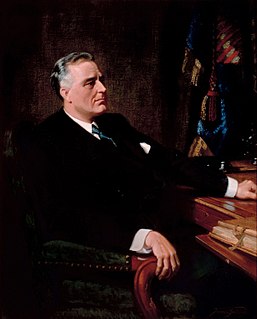The National Committee to Uphold Constitutional Government (NCUCG), also known as the Committee for Constitutional Government (CCG), [1] was founded in 1937 in opposition to Franklin D. Roosevelt's Court Packing Bill. The Committee opposed most, if not all, of the New Deal legislation.

Franklin Delano Roosevelt, often referred to by his initials FDR, was an American statesman and political leader who served as the 32nd president of the United States from 1933 until his death in 1945. A member of the Democratic party, he won a record four presidential elections and became a central figure in world events during the first half of the 20th century. Roosevelt directed the federal government during most of the Great Depression, implementing his New Deal domestic agenda in response to the worst economic crisis in U.S. history. As a dominant leader of his party, he built the New Deal Coalition, which realigned American politics into the Fifth Party System and defined American liberalism throughout the middle third of the 20th century. His third and fourth terms were dominated by World War II. Roosevelt is widely considered to be one of the most important figures in American history, as well as among the most influential figures of the 20th century. Though he has been subject to substantial criticism, he is generally rated by scholars as one of the three greatest U.S. presidents, along with George Washington and Abraham Lincoln.

The New Deal was a series of programs, public work projects, financial reforms, and regulations enacted by President Franklin D. Roosevelt in the United States between 1933 and 1936. It responded to needs for relief, reform, and recovery from the Great Depression. Major federal programs included the Civilian Conservation Corps (CCC), the Civil Works Administration (CWA), the Farm Security Administration (FSA), the National Industrial Recovery Act of 1933 (NIRA) and the Social Security Administration (SSA). They provided support for farmers, the unemployed, youth and the elderly. The New Deal included new constraints and safeguards on the banking industry and efforts to re-inflate the economy after prices had fallen sharply. New Deal programs included both laws passed by Congress as well as presidential executive orders during the first term of the presidency of Franklin D. Roosevelt.
Founders of the Committee were Frank Gannett, Amos Pinchot and Edward Rumely. The organization enjoyed considerable success in opposing the Bill, also because of large mailing list campaign targeted at legal professionals.
Frank Ernest Gannett was an American publisher who founded the media corporation Gannett Company. He began his career in 1906 as half owner of the Elmira Gazette. He soon added newspapers in Ithaca, Rochester, Utica, and other cities in upstate New York. At the time of his death, the chain included 22 daily newspapers, four radio stations, and three television stations, largely based in the state of New York. Gannett was known for granting editorial autonomy to the different media, while consolidating and standardizing business procedures and purchases. Gannett disliked sensationalism, so his media played down crime and scandal, and rejected advertising for liquor. A conservative Republican, he was active in state and national politics. He was the unsuccessful Republican candidate for governor of New York in 1936, and in 1942 was assistant chairman of the Republican National Committee. In 1935 he established the Gannett Foundation to own the business, and provide philanthropy.

Amos Richards Eno Pinchot was an American lawyer and reformist. He never held public office but managed to exert considerable influence in reformist circles and did much to keep progressive and Georgist ideas alive in the 1920s.

Edward Aloysius Rumely (1882–1964) was a physician, educator, and newspaper man from Indiana.
Pinchot would later lead an America First chapter in New York City, although the committee itself was silent on the foreign policies of Roosevelt, and included many interventionists as its members. Gannett would become a presidential candidate in 1940.

The America First Committee (AFC) was the foremost United States non-interventionist pressure group against the American entry into World War II. Started on September 4, 1940, it experienced mixed messaging with antisemitic and pro-fascist rhetoric from leading members, and it was dissolved on December 10, 1941, three days after the attack on Pearl Harbor had brought the war to America. Membership peaked at 800,000 paying members in 450 chapters. It was one of the largest anti-war organizations in American history.

The City of New York, usually called either New York City (NYC) or simply New York (NY), is the most populous city in the United States. With an estimated 2017 population of 8,622,698 distributed over a land area of about 302.6 square miles (784 km2), New York is also the most densely populated major city in the United States. Located at the southern tip of the state of New York, the city is the center of the New York metropolitan area, the largest metropolitan area in the world by urban landmass and one of the world's most populous megacities, with an estimated 20,320,876 people in its 2017 Metropolitan Statistical Area and 23,876,155 residents in its Combined Statistical Area. A global power city, New York City has been described as the cultural, financial, and media capital of the world, and exerts a significant impact upon commerce, entertainment, research, technology, education, politics, tourism, art, fashion, and sports. The city's fast pace has inspired the term New York minute. Home to the headquarters of the United Nations, New York is an important center for international diplomacy.
Other people associated with the Committee were U.S. Representative Samuel B. Pettengill, John M. Pratt, Ralph W. Gwinn, John T. Flynn and Robert E. Wood.

The United States House of Representatives is the lower chamber of the United States Congress, the Senate being the upper chamber. Together they compose the legislature of the United States.
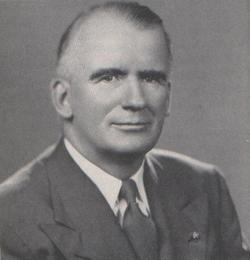
Samuel Barrett Pettengill was a U.S. Representative from Indiana, representing Indiana's 3rd congressional district and nephew of William Horace Clagett.
John Morgan Pratt was a tax resistance leader, activist in the Old Right, publicist and newspaper man. Along with James E. Bistor, he led what was probably the largest tax strike since the Era of the American Revolution.
The Committee was thrice investigated by Congress for suspected lobbying activities. Most notably, Rumely was twice indicted for Contempt of Congress. In 1946, he was acquitted in the second Congressional investigation. In 1953, he was cleared in the third Congressional investigation, a case he pleaded all the way to the United States Supreme Court on appeal.
Contempt of Congress is the act of obstructing the work of the United States Congress or one of its committees. Historically, the bribery of a U.S. Senator or U.S. Representative was considered contempt of Congress. In modern times, contempt of Congress has generally applied to the refusal to comply with a subpoena issued by a Congressional committee or subcommittee—usually seeking to compel either testimony or the production of requested documents.

The Supreme Court of the United States (SCOTUS) is the highest court in the federal judiciary of the United States. Established pursuant to Article III of the U.S. Constitution in 1789, it has original jurisdiction over a narrow range of cases, including suits between two or more states and those involving ambassadors. It also has ultimate appellate jurisdiction over all federal court and state court cases that involve a point of federal constitutional or statutory law. The Court has the power of judicial review, the ability to invalidate a statute for violating a provision of the Constitution or an executive act for being unlawful. However, it may act only within the context of a case in an area of law over which it has jurisdiction. The court may decide cases having political overtones, but it has ruled that it does not have power to decide nonjusticiable political questions.
